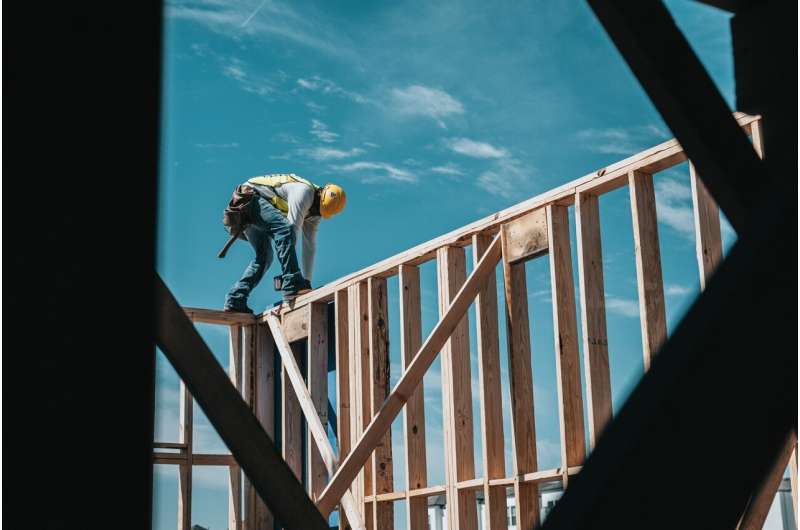Despite the promotion of wood construction, wooden multi-story buildings are still rare in Finland. Why is that?

The use of wood promotes sustainable development in construction. However, its costs are considered high and there are prejudices about its quality, which makes it difficult for industrial wood construction to become more common in Finland. According to Jaakko Jussila's new doctoral dissertation from the University of Vaasa, wood construction should be more customer-oriented instead of just focusing on technology and cost-efficiency issues.
"Dwellings should not be produced to meet contractors," investors' or civil servants' requirements, but the residents' needs. The industry should keep the customer in mind when developing product features and construction processes," says Jussila, who will be defending his doctoral dissertation at the University of Vaasa on Friday, 18 November.
Wood construction would reduce the carbon footprint
Wood construction has developed and gained related interest in recent years. This has also been supported by social pressure to develop low-carbon construction.
"The use of wood is recognized as one of the key ways to reduce the carbon footprint of construction, as wood is a renewable raw material that holds carbon for decades and is easily recyclable. However, we know from research and in practice that the adoption of large-scale wood construction has been slow in Finland, despite the well-known benefits of wood construction and the measures to promote it," says Jussila.
Jussila's recent doctoral dissertation discusses the adoption of wood construction as part of the sustainability transformation in construction. The dissertation discusses various factors that are promoting and hindering wood construction from the perspective of Finnish municipal decision-makers and institutional factors in particular.
"Municipalities play a significant role in promoting wood construction not only as instances in public construction but also because of their monopoly on land use planning."
Jussila has conducted an extensive literature review in his doctoral dissertation. In addition, he has interviewed municipal decision-makers about their views on sustainable construction and the identified factors that hinder and promote wood construction.
Pros: good product properties. Cons: high-perceived costs
Positive product properties and product innovations, such as improved construction efficiency through prefabrication, promote industrial wood construction. On the other hand, higher costs, prejudices related to quality, lack of experience and well-established production methods are examples of factors that are hindering wood construction. In addition, the municipal decision-makers interviewed in the research identified limited supply together with unfavorable regulation as factors hindering the development of industrial wood construction.
Land use planning and land use are essential in promoting wood construction
The research results show that the majority of municipalities had adopted objectives and practices to promote sustainable construction. Most commonly, this meant the pursuit of energy efficiency and carbon neutrality, life cycle-focused thinking and the promotion of the use of renewable energy. Alongside these, wood construction was considered a part of sustainable construction. Many municipalities are confident that the existing provisions and regulations are sufficient to promote sustainable construction, which in turn highlights the importance of institutional factors, regulation in particular.
Many municipalities identified ways to promote wood construction. Land use planning and zoning, supporting local businesses, the construction of detached houses and setting environmental objectives for new residential areas were the most common. Thus, municipalities have several means at their disposal to promote sustainable construction and wood construction.
Excessive regulation should not become a barrier
The climate crisis and sustainability transformation are causing a need for change in virtually every organization—the construction industry is not immune to this pressure for change. Adapting to change requires taking risks and making investments, but it also creates new business opportunities and, at best, makes companies perform more efficiently.
"In recent years, expectations have been set for public construction about the use of wood, but it is important to note that not only municipalities are responsible for promoting wood construction. The competitiveness of wood products and increasing consumer demand for wood construction are key elements for the growth of commercial housing production. Excessive regulation should not become an obstacle," says Jussila.
The producer-oriented perspective has become more important
So far, research on the construction of wooden multi-story buildings has largely focused on the perspectives of housing producers, especially construction companies, element manufacturers and designers as well as the pros and cons of the construction of wooden blocks of flats. In contrast, limited research has been focusing on housing transactions and residential experiences. In addition, only a few studies have examined the role of institutions or municipal decision-makers in the construction of wooden multi-story buildings, although their importance has been recognized. Jussila's doctoral dissertation contributes to filling in these research gaps.
More information: Transformation towards sustainability in the construction market: Adoption of wood construction in Finland. urn.fi/URN:ISBN:978-952-395-039-9




















